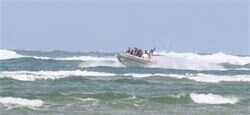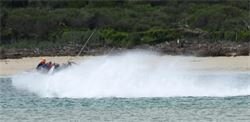About Us
Operating in South Gippsland we offer many choices in your enjoyment of the waters around Wilson's sPromontory. We love all aspects of the water in all its moods - the fun of the waves, the tranquillity of the Franklin River and the sheer pleasure derived from the absolute freedom of the ocean. We want to share this with you.
Our Prom Coast Discovery Tours are a fabulous way to see the coastline of magnificent Wilson's Promontory and the surrounding islands, as well as enjoying an exciting ride in an open boat down along the Tasman Sea.
The Kraken is a 7.8m RIB that is also capable of high speed crew and cargo transport. A great platform for Photography and other forms of filming.
Location:
South Gippsland
Hours:


By arrangement
The Legend of the Kraken
Probably no legendary sea monster was as horrifying as the Kraken. According to stories this huge, many armed, creature could reach as high as the top of a sailing ship's main mast. A kraken would attack a ship by wrapping their arms around the hull and capsizing it. The crew would drown or be eaten by the monster. What's amazing about the kraken stories is that, of all the sea monster tales we have, we have the best evidence that this creature was based on something real.
Tales of a huge, many armed, headed or horned sea creatures exist from ancient times. The Greek legend of the Scylla, a monster with six heads that Odysseus must sail past during his travels, is an example of this tradition. In 1555 Olaus Magnus wrote of a sea creature with "sharp and long Horns round about, like a Tree root up by the Roots: They are ten or twelve cubits long, very black, and with huge eyes..."
Although the term kraken is first found in print in Systema Naturae (Carolus Linnaeus - 1735), stories about this monster seem to date back to twelfth century Norway. These tales often refer to a creature so big that it is mistaken for an island or series of islands. Even as late as 1752, when the Bishop of Bergen, Erik Ludvigsen Pontoppidan, wrote his The Natural History of Norway he described the kraken as "incontestably the largest Sea monster in the world" with a width of one and a half miles. The Bishop also noted that the animal had starfish type protuberances: "It seems these are the creature's arms, and, it is said, if they were to lay hold of the largest man-of-war, they would pull it down to the bottom." Despite this Pontoppidan says that the most danger the kraken represented to ships came from the disturbance it made as it came to the surface or whirlpool as created as it descended below. Because fish were attracted to the vicinity of the kraken, he also notes, Norwegian fishermen would often fish over the creature, despise the risk to their ship and their lives.
The Kraken of legend is probably what we know today as the giant squid. While a colossal octopus might also fit the description, the squid is thought to be much more aggressive and more likely to come to the surface where it might be seen by man. Though giant squids are considerably less then a mile and a half across, some are thought to be large enough to wrestle with a whale. On at least three occasions in the 1930's they reportedly attacked a ship. While the squids got the worst of these encounters when they slid into the ship's propellers, the fact that they attacked at all shows that it is possible for these creatures to mistake a vessel for a whale.
Is it a Kraken or a Giant Squid?
Could a large squid, say a hundred feet long and weighing two or three tons, attack a small ship by accident and capsize it? Given that some ocean crossing vessels at the time were very small (for example, Columbus's Pinta was only 60 feet in length), it certainly seems a possibility. Allegedly this is what occurred to sailing ships.